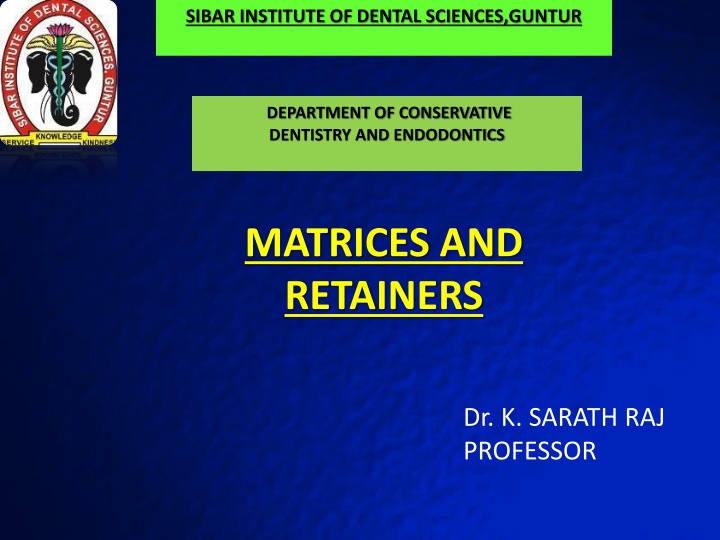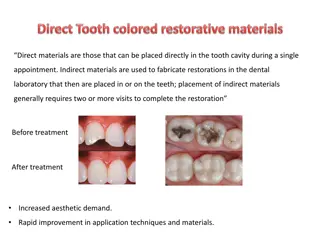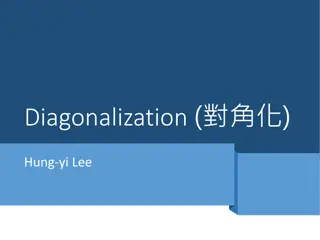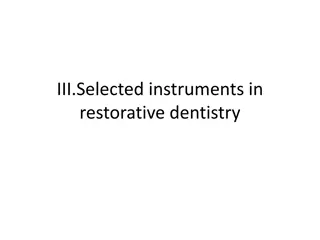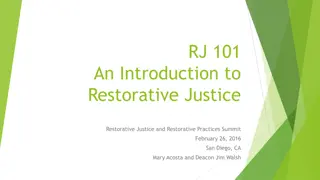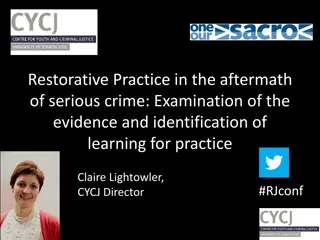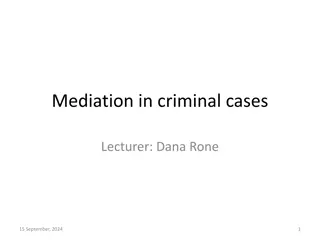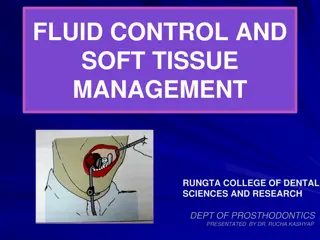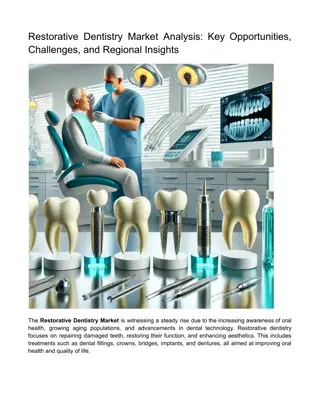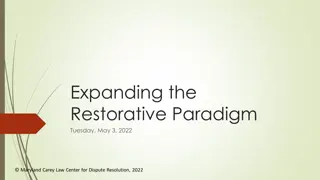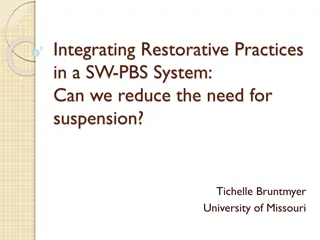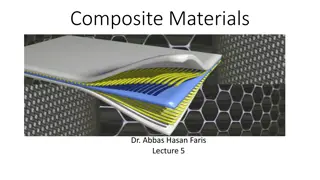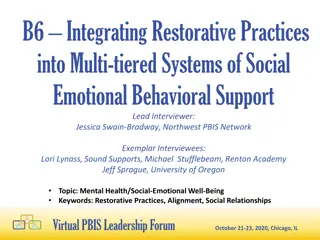Matrix Systems in Restorative Dentistry: A Comprehensive Overview
Understanding the role of matrices and retainers in restorative dentistry is crucial for achieving optimal results in direct restorative procedures. This article covers the definitions, ideal requirements, functions, and parts of matrices, providing valuable insights into their importance and usage in dental practice.
Download Presentation

Please find below an Image/Link to download the presentation.
The content on the website is provided AS IS for your information and personal use only. It may not be sold, licensed, or shared on other websites without obtaining consent from the author.If you encounter any issues during the download, it is possible that the publisher has removed the file from their server.
You are allowed to download the files provided on this website for personal or commercial use, subject to the condition that they are used lawfully. All files are the property of their respective owners.
The content on the website is provided AS IS for your information and personal use only. It may not be sold, licensed, or shared on other websites without obtaining consent from the author.
E N D
Presentation Transcript
SIBAR INSTITUTE OF DENTAL SCIENCES,GUNTUR DEPARTMENT OF CONSERVATIVE DENTISTRY AND ENDODONTICS MATRICES AND RETAINERS Dr. K. SARATH RAJ PROFESSOR
Contents Introduction Definitions Ideal requirements of matrix Functions of matrix Parts of matrix Benefits of ideal contacts and contours Classification of matrices Description of various matrices Conclusion References
Introduction: When direct restorative materials are inserted into prepared cavities they are in a plastic state,ie, they are still soft and pliable. For optimum adaptation of these materials into the prepared cavity details, the preparation must be box-like with confining walls and floors.
In case of Class II or class III cavity (missing walls) Temporary wall is placed to hold the restorative material within the tooth- Achieved by matrices. Matrices: used when 1 or more wall are missing & to establish proper anatomic contour and proximal contacts without gingival overhangs. Simple metal or plastic strip to a circumferential band of metal encircling entire crown.
Definitions: Matricing: Is the procedure whereby a temporary wall is created opposite to axial walls, surrounding areas of the tooth structure that were lost during cavity preparation. Matrix: Is a device used during restorative procedures to hold the plastic restorative material within the tooth while it is setting.
Ideal requirements of a matrix: 1. Ease of application 2. Not be cumbersome 3. Easy to remove 4. Rigidity 5. Versatility (Easy adaptability and fixedness to the teeth) 6. Height 7. Proper Proximal contact and contour 8. Positive proximal pressure 9. Nonreactive 10. Inexpensive
Functions of a matrix: To confine the restorative material while it is hardening. To establish optimal contacts and contours for the restoration To prevent gingival overhangs of the restoration To provide an acceptable surface texture for the restoration.
Parts of a matrix: 1.Band 2.Retainer
Band: This is a piece of metal or polymeric material used to support and give form to the restorative material during its insertion and hardening. Materials: Stainless steel, cellulose acetate(cellophane), cellulose nitrate(celluloid) and polyacetate(mylar). Dimensions:0.001 to 0.002 inch thickness,3/16th inch,1/4th inch, 5/16th inch width.
Retainer: Is a device by which the band can be maintained in its designated position and shape. The retainer may be mechanical device,dental floss, a metal ring or impression compound.
CONTACTS & CONTOUR Location of proximal contact area is normally, Maxillary & mandibular anteriors : incisal third & positioned slightly facial. Maxillary & mandibular posteriors :near the junction of occlusal and middle third or in the middle third.
BENEFITS OF AN IDEAL CONTACT AND CONTOUR: Health of periodontium Prevents food impaction Self cleansable Longevity of proximal restoration Normal mesio-distal relationship
Classification of matrices: Depending on the type of band material: Stainless steel Copper band Cellulose acetate(cellophane) Cellulose nitrate(celluloid) Polyacetate(mylar).
Depending on its preparation: Custom made or anatomic matrix Eg: compound supported matrix Mechanical matrix Eg:Ivory No 1, Ivory No 8, Tofflemire matrices
Depending on mode of retention: 1.With retainer Eg:Tofflemire, Ivory No 1, Ivory No 8 matrices. 2.Without retainer Eg:Automatrix
Depending on cavity preparation for which it is used: Class I cavity for buccal or palatal extensions: Eg: Double banded tofflemire matrix. Class II cavity: Eg: Single banded tofflemire Ivory No. 1 & Ivory No. 8 matrices Compound supported matrix Copper band matrix T-band matrix Pre-contoured sectional matrix Automatrix
Class III cavity: S-shaped matrix Cellophane strips Mylar strips Class IV cavity: Cellophane strips Modified S shaped matrix aluminium foil Dead soft metal matrix strips Transparent celluloid crown forms
Class V cavity Window matrix Tin foil matrix Preformed transparent cervical matrix
Description of various matrices: Ivory No. 1 matrix: -Matrix:Stainless steel band which encircles one proximal surface of a posterior tooth. -Band is attached to a retainer via wedge shaped projection. -Adjusting screw-adapts band to the proximal contour of the prepared tooth. -Clockwise rotation of screw: wedge shaped projections engage the tooth at embrasures of Unprepared proximal surface.
In middle of band one margin is slightly projected, which is kept toward the gingiva on the cavity side. Free end of matrix band are kept on the non cavity side. Indication: Unilateral class II cavity(MO or DO) When contact on unprepared tooth surface is tight.
Ivory No. 8 matrix: MATRIX: Consists of a band that encircles the entire crown of the tooth. Circumference of band can be adjusted by a screw. Indications: -class II cavities( 1 or both Proximal surfaces) Disadvantage:(Ivory no.1 & 8) -Old technique-not in use -Cumbersome to place & remove.
Tofflemire matrix: -B.R. Tofflemire -Universal matrix Parts: VICE MOVING NUT VICE SCREW NUT VICE SCREW SLOTS
Uses of Tofflemire matrix : -Class II Amalgam restorations (MO/DO/MOD) -Class I Amalgam restorations with Palatal/Buccal extensions
Head: Accomodates matrix band It is U shaped with 2 slots Slots in head is directed gingivally while positioning. 2types: Straight tofflemire retainer: Head is straight. Retainer placed only on buccal side Contra-angled tofflemire retainer: Head is angled. Retainer placed on buccal/lingual side.
Locking Vise: It has a diagonal slot Locking Vise is positoned near the head for placing the band in the retainer & positioning it around the tooth. Pointed spindle: Is used to adjust distance between head and locking vise & also to adjust size of loop of matrix band.
Vice screw nut: Turning this nut clockwise tightens the pointed spindle against band & thus secures band in retainer. Reverse motion-releases pointed spindle, releasing band from retainer. Vice moving nut: Used to adjust size of loop of matrix band either to tightly adapt it against tooth or to loosen it from tooth.
-Standard: Adult dentition -Small: Primary dentition Bands of tofflemire: -Precontoured bands 2 sizes of tofflemire retainer available:
Non contoured bands: used in Ivory no 8 retainer Thickness of band : 0.002inch/0.05mm - 0.0018inch/0.038mm Height of band: 3/16 5/16 inch or 4.7-7.9mm
Gingival edge of band has smaller circumference than occlusal edge. Similar to contour of tooth Slot facing gingivally and retainer parallel to buccal surfaces of the teeth
Trimming occlusal height of the matrix band with the help of crown sheers. Reflecting the handle to permit insertion of mesial wedge on retainer side.
Tofflemire matrix: Indications: Class I cavities with buccal or palatal extensions Class II cavities (1 or both proximal surfaces). Advantages: Ease of use Good contact & contour for most of amalgam restorations. Rigid and stable Disadvantages: Do not provide optimum contact & contour for posterior composite restorations Not useful for extensive class II restorations
Precontoured sectional matrices and contact rings: Are currently more popular while restoring class II cavities with composite resins Dead soft metal matrices(various shape,size & thicknesses). Selected according to tooth size & wedged to adapt to gingival margins of preparation. Band is held in contact ring(retainer). Special forceps to place contact ring. Contact rings-Stabilizes ends of matrix band snugly against facial & lingual embrasures adjacent to proximal box.
Various Contact matrices are:- First generation: Composi-Tight (Garrison Dental) BiTine rings (Pallodent) Second generation: V 3 ring system (Triodent) Composi-Tight 3D soft face ring system (Garrison Dental Solutions)
BiTine rings Composi-Tight rings Precontoured sectional matrices Precontoured matrix & ring in place
Basic principle of contact rings: These rings work by providing slight separation of contacting teeth. When the ring is expanded and its tines are placed b/w the contacting teeth,its spring action applies equal & opposite forces against the teeth thus providing optimum separation.Helps to achieve tight contacts with posterior composites. Following placement of composite restoration, the ring is removed & teeth are brought back into contact. Wedge placed-optimal gingival adaptation of matrix band.
Composi-Tight 3D soft face ring & matrix V 3 matrix system
Precontoured sectional matrices & contact rings Indications: Small to moderate Class II cavities (1 or both proximal surfaces) Amalgam & composite restorations. Advantages: Ease of placement & removal & good visibility Anatomic contour of band ensures optimal contact areas & embrasures Adequate contact dimensions & correct anatomic location - minimize overhangs, tight marginal seal Good gingival adaptation of restoration.
Disadvantages: Expensive Matrix band easily dented if contact areas are too tight.
Clear plastic matrix: Transparent plastic strips tooth coloured restorations. Allow light to be transmitted during polymerization of composite resins. Cellophane or mylar strips (contoured with operating pliers). Band-extend 1mm beyond gingival & incisal margins of cavity preparation. Stabilized by light transmitting wedge.
After inserting composite resin, matrix is pulled tightly around tooth following which light curing is done. After restoration is completed, wedge is removed & matrix strip slid out of proximal surfaces of contacting teeth. Indications: Class III & IV tooth colored restorations Advantages: Easy to use inexpensive
Transparent plastic crown form matrix: Various sizes & contours for anteriors. Suitable crown form selected for prepared tooth & trimmed to fit 1mm past the prepared margins. Contact area is thinned with an abrasive disk. Bulk of composite resin is loaded into crown form and then positioned over tooth & light cured. Thus, contours of the tooth can be shaped easily.After curing, the crown form can be slit with a bur & removed.
Transparent plastic crown form matrix: Indications: For large class IV cavities For oblique fractures of anterior teeth. Advantages: Easy to use Good contours can be established. Disadvantages: Time consuming expensive
Window matrix: Modification of tofflemire matrix Class V amalgam restoration Contra-angled tofflemire retainer is applied on the lingual side of the tooth. A window is cut in the band slightly smaller than the outline of the cavity. Wedges are placed interproximally to stabilize the band. Following this amalgam can be condensed through the window & contoured using carvers. Matrix is removed once the amalgam has hardened.
Tin foil matrix: Class V restorations for conventional GIC. Tin foil are preshaped or cut acc. to buccal or lingual surfaces of teeth to be restored. Band should extend 1 to 2mm beyond the cavity margins. Adapted on the cavity by tweezer after placing GIC. Once restoration sets tin foil matrix can be peeled away.
Tin foil matrix: Indications: Class V restorations with conventional GIC. Advantages: Simple & easy to use Provide optimum contour for restoration Disadvantages: Not useful for Class V composite or resin modified GIC.
Preformed transparent cervical matrices: Various contours (anteriors & posteriors) Composite restorations, RMGIs Handle/Tweezer can hold the matrix in place while restoration is hardening.
Preformedtransparent cervical matrices: Indications: Class V restorations with Composite, RMGIs. Advantages: Good contour Disadvantages: Expensive
